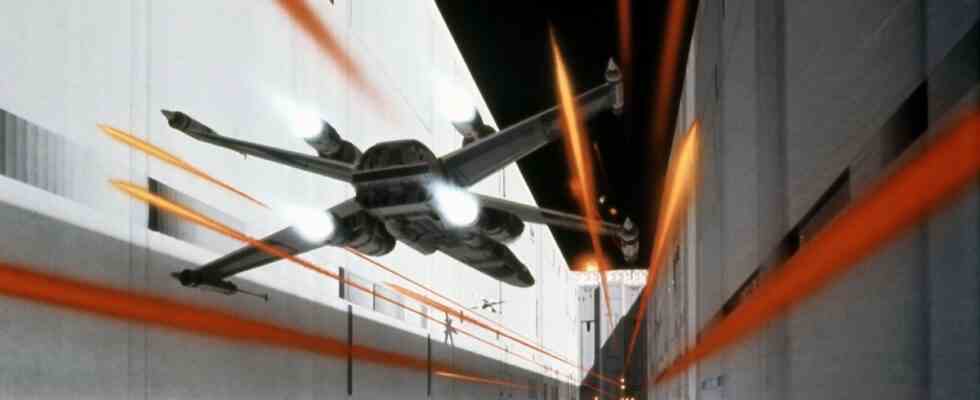Don’t have a fiber optic connection yet? It doesn’t matter, air will do too. At least for a team led by electrical engineer Andrew Goffin from the University of Maryland: As early as 2021, the researchers sent a laser beam through their institute hallway and melted a hole in the wall almost 50 meters away. Like the laser physicists now in the specialist journal Physical Review X to report, the air practically became a fiber optic cable – with a record length. The laser remained focused 60 times further than before.
But why do you need an aerial cable for laser beams? “A laser doesn’t stay focused forever,” says Stefan Karsch, explaining the problem. The physicist researches the development of high-intensity lasers at the University of Munich. “The joke is to prevent the divergence.” Because even if laser beams can be bundled by lenses, their light cone widens with increasing distance, which reduces the intensity of the light per area. You know that from flashlights: aimed at distant objects, they throw an ever larger circle of light with decreasing brightness.
Therefore, wafer-thin fiber optic cables are usually used as fiber optic cables. Such glass fibers have a coaxial structure, i.e. they consist of a core and a cladding. By introducing fewer foreign atoms into the core material, the core and cladding differ in the so-called refractive index, a measure of the propagation speed of light. This difference is sufficient for “total reflection” to occur at the boundary layer between core and cladding: All light is reflected without loss and propagates in a zigzag along the interior of the cable.
Instead of using a real cable, Goffin and colleagues used a trick to guide the laser light: additional lasers. With the help of laser pulses lasting just 300 femtoseconds, they created a kind of plasma path in the air before the actual beam was emitted. Plasma is a hot particle state in which air molecules are partially ionized. The effect also occurs with lightning, which French researchers recently used to derive lightning strikes on the Swiss Säntis using laser fire.
Laser bullets don’t hiss or whistle, they thunder
In the Hallway experiment in Maryland, the air, heated by the plasma, suddenly expanded, leaving behind a low-density column of air. Arranged in a circle, many of these low-density air columns formed a cylinder jacket made of so-called filaments. Inside the cylindrical enclosure, a five millimeter diameter core with a higher density was formed. “The ring-shaped heating of the air creates a higher refractive index in the center of the ring than at the edge,” says laser physicist Karsch. Total reflection then occurred at the density difference between core and cladding, just like with the glass fiber: The green main laser was forced into a channel and guided to the wall for a few milliseconds with constant intensity, before the density difference in the air disintegrated again.
Laser-pulsed air as a “virtual” glass fiber could be used in the future to detect pollution in the atmosphere. Similar measurements are already being carried out, for example with the help of “lidar” systems: Here, a laser is shot vertically into the atmosphere. The light is then thrown back from different layers to telescopes on earth and the height of the pollution layer is determined from the transit time. “With further development, a guided laser could be used to follow the lidar light of moving objects with high spatial resolution, for example to measure the pollutant emissions from aircraft,” says Peter Hommelhoff, a laser physicist from the University of Erlangen.
The authors of the study also hope for advances in laser communication over long distances. “A virtual fiber optic will still not beat a normal fiber optic,” Hommelhoff is certain. Stefan Karsch therefore considers it more likely to be used in another area: “Laser weapons are a possible application.” While laser cannons like those used in the “Death Star” in the Star Wars films will remain science fiction, it is not surprising that the study was co-funded by US Army funds.
For their laser experiment, the researchers locked a hallway in the university at night.
(Photo: Intense Laser-Matter Interactions Lab, UMD / CC BY-ND)
In any case, the laser beam in the university corridor was not entirely harmless. In order to prevent a lost student from stumbling into the measurement setup and being hit by the laser shot, the researchers secured the experiment several times. They experimented at night, blocking off the corridor with caution tape and hanging light-absorbing black curtains. In addition, reflective surfaces were masked to protect against blindness caused by stray light.
However, once in operation, the laser also drew attention to itself acoustically. It banged and cracked as the ceramic stone in the wall at the end of the hallway began to steam, smelling like metal. The noise came not only from the plasma spot on the wall surface, but also from the sudden expansion of air along the laser path. The physicists recorded the sound waves through a row of microphones in order to use the volume to measure the quality of the waveguide. As in a thunderstorm, one could hear “little cousins of a thunder”, according to an accompanying press release to the study. For the next sci-fi movie, this means: Laser cannons should actually thunder instead of go “piu piu”.

